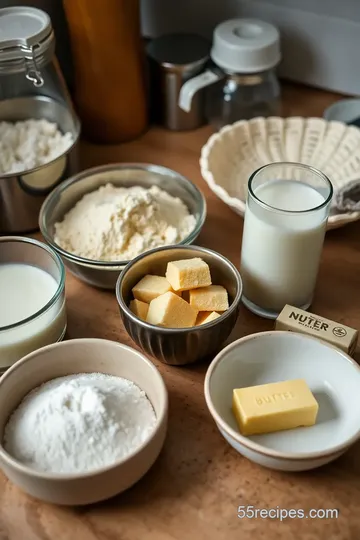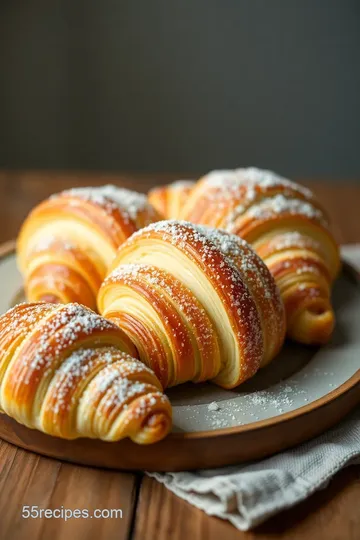Heavenly Flaky Croissants with Swiss Butter
Craving delicious homemade croissants? Bake Flaky Croissants with Swiss Butter using my easy recipe and enjoy that heavenly flavor for breakfast or brunch!

- Recipe Overview
- Key Benefits
- Essential Ingredients Guide for Bakin’ Flaky Croissants with Swiss Butter
- Mastering Professional Cooking: Bake Flaky Croissants with Swiss Butter
- Pro Tips & Secrets for Perfect Croissants
- Perfect Presentation: Croissants that Wow
- Storage & Make-Ahead Tips
- Creative Variations: Spice It Up!
- Complete Nutrition Guide
- Frequently Asked Questions
- Recipe Card
Have you ever woken up to the smell of warm, buttery croissants wafting through the air? oh my gosh , there’s nothing like it! i remember the first time i took a bite of a homemade croissant.
I was a novice baker, and i was intimidated. but as i sank my teeth into that golden, flaky pastry, all my fears melted away.
That first bite made me realize the magic of baking, and that's why i’m excited to share my journey on how to bake flaky croissants with swiss butter .
Trust me, you’ll want to join me on this delicious adventure.
Croissants have a rich history that dates back to 13th-century austria. they found their way to france and became a staple of french pastry culture.
Today, they are loved all over the world, gracing our breakfast and brunch tables. these butter-layered pastries are not just delicious; they are an embodiment of tradition and craftsmanship, thanks to their unique croissant dough lamination technique.
Now, don’t let that technical jargon scare you away! sure, making croissants can be a bit of a process, but with a little patience, even beginners can whip up these beauties.
Honestly , once you master it, the satisfaction you feel is off the charts. expect around four hours total from start to finish, but most of that is just letting the dough chill out.
Plus, you’ll end up with 12 golden brown pastries that will wow anyone who gets a taste!
Recipe Overview
Let’s talk money. baking at home is often cheaper than buying gourmet pastries. for just a few bucks, you can create a batch of flaky croissants that would normally cost a pretty penny at your local café.
Just make sure you’ve got good-quality ingredients, like that rich swiss butter . it's what takes your croissants from "meh" to "wow" in terms of flavor.
And about spending time in the kitchen—don’t stress! croissants require some love and time, but they aren’t impossible. the most important stages are the dough rising techniques and the rolling-out process.
You can pick up some solid pâtisserie techniques along the way and impress your family and friends at brunch.
Key Benefits
Okay, let’s get to the good stuff— why you should bake these croissants . first off, they’re surprisingly healthy compared to a lot of breakfast options out there.
Swapping out some ingredients for whole grain or even adding fillings like almonds or dark chocolate can boost their nutritional profile while still keeping them delectable.
And did i mention versatility? these homemade croissants can be sweet or savory. feeling like a chocolate fix? toss in some chocolate chips! want to impress guests? make ham and cheese croissants.
The options are endless!
Special occasions, lazy weekends, or any day ending in "y"? croissants fit perfectly. whether you’re hosting brunch or just indulging on a quiet morning, these pastries are truly a delight.
Trust me, once you have them fresh out of the oven, you’ll understand why they’re a staple of french culinary tradition .
So, are you ready to dive into the delicate world of croissants? let’s gather our ingredients and embark on this delicious adventure together! we’re going to elevate your baking from ordinary to extraordinary, one buttery layer at a time.
Now let’s move on to the ingredients you’ll need to make your own batch of heavenly flaky croissants!

Essential Ingredients Guide for Bakin’ Flaky Croissants with Swiss Butter
When it comes to baking flaky croissants with swiss butter , knowing the core ingredients is like having a treasure map.
Let’s break it down into bite-sized pieces, easy to digest, and fun to whip up!
Premium Core Components
Let’s start with the essentials . The quality of your ingredients can make or break your croissants! Here’s the scoop:
-
Flour: you need about 4 cups (500g) of all-purpose flour . look for a brand that feels soft to the touch and has a higher protein content.
This is your base, so if it's low quality, your croissants might turn out flat.
-
Butter: here’s where swiss butter shines! you’ll need 1 cup (225g), cold and slightly softened . high-quality butter adds that rich flavor and helps achieve those lovely layers.
You want to avoid anything that’s overly processed—stick with the good stuff!
-
Yeast: you need 1 packet (2¼ teaspoons / 7g) of active dry yeast . make sure it's fresh! a quick way to check is to dissolve it in warm water and see if it foams up.
If it doesn’t, toss it and grab a new one.
-
Milk: About 1½ cups (360ml) of whole milk , warmed to around 110° F ( 43° C) . This warmth helps awaken the yeast. Don’t go boiling hot, or you’ll kill it!
Storage and Freshness Tips
Once you have your goodies, how you store them matters:
-
Flour can live happily in a cool, dry space for about 6-12 months . If you can, keep it in an airtight container to prevent any uninvited guests (like bugs).
-
Swiss butter ? keep it in the fridge and use it within a month for the best flavor. if you have to stash it longer, consider freezing it.
It can hold up to 6-9 months when perfectly wrapped.
The trick is to keep everything nice and chill, which brings me to our next section.
Signature Seasoning Blend
While our dough is rolling, let’s sprinkle some flavor into the mix. This is where the magic happens !
-
Essential spices: For croissants, you might not think you need spices, but a bit of salt (2 teaspoons or 10g) helps enhance the sweetness of the butter.
-
Herb selections: though traditional croissants are plain, feel free to experiment with herbs like thyme or rosemary if you’re feeling adventurous! they can add a savory twist to your creations.
You can do a sweet or savory version, depending on your brunch ideas!
Smart Substitutions
Sometimes, life throws curveballs. Don’t fret—here are some smart substitutions !
-
If you find yourself out of all-purpose flour , you can try whole wheat flour —but it may change the texture a bit.
-
No Swiss butter ? No worries! High-quality European-style butter will do just fine and still give you those pretty layers.
-
For the milk, if you’re going dairy-free, almond or oat milk can step in perfectly.
Kitchen Equipment Essentials
Baking croissants isn’t just about ingredients; it’s also about having the right tools. Here’s a quick rundown of must-haves:
-
Mixing Bowls: Get yourself a couple of good-sized bowls. Trust me; you'll need them.
-
Rolling Pin: This is crucial for that croissant dough lamination . You want to roll out that dough nice and evenly, so choose one you love.
-
Baking Sheets and Parchment Paper: Essential for sliding those beauties into the oven without them sticking.
-
Pastry Brushes: For egg washing your croissants so they get that beautiful shine!
-
Plastic Wrap and a Bench Scraper: This will help you keep everything tidy when you’re working with dough.
With all these goodies in hand, you’re ready to tackle the adventure of making homemade croissants . Just think—every layer you fold is one step closer to achieving those gorgeous, butter-layered pastries that’ll have everyone begging for the recipe!
Next up, we’ll dive into step-by-step instructions to make your baking journey even smoother! Ready to get those croissants rolling?

Mastering Professional Cooking: Bake Flaky Croissants with Swiss Butter
So, you’ve got that itch to bake some homemade croissants , huh? let me tell you, there’s nothing quite like the aroma of freshly baked, buttery pastries wafting through your kitchen.
And trust me, if those croissants are made with rich swiss butter , you’re in for an absolute treat. while it may seem like rocket science, let’s break it down.
We're going to chat about some essential cooking methods that'll make your croissant game strong, starting with preparation.
Essential Preparation Steps
First off, we gotta talk about mise en place , which is just a fancy way of saying “have everything ready to go before you start.
” seriously, nothing’s worse than scrambling to find your ingredients while dough sits there looking sad. so, measure out your 4 cups of flour and have your 1 cup of swiss butter cropped and ready.
Next up: time management . croissants need love, and that means waiting. you’re looking at about 3 hours chilling time after mixing the dough.
If you can plan your day right, you can squeeze in some netflix while that dough is doing its thing!
Organization is super key here. keep your workspace neat. i often have a little bowl for scraps and always clean as i go.
It saves a ton of stress later. and don’t forget about safety ! baking should be fun, not dangerous, so keep sharp knives away from untrained hands and remember that ovens get hot.
Step-by-Step Process
Alright, here comes the fun part—baking! Follow these clear, numbered steps for success.
- Prepare the Dough : Mix 110° F warm milk with your active dry yeast . Let it sit for 5 minutes until foamy.
- In a bowl, combine your 4 cups flour , 2 tablespoons sugar , and 2 teaspoons salt . Slowly add that yeast mix and 3 tablespoons melted butter .
- Knead that dough for 10 minutes . Get in there; use those muscles!
- Cover it and let it rise in a warm spot for 1 hour , or until it’s doubled in size.
You’ll then make the star of the show—the butter layer. Roll it out into a rectangle and keep it chilly. Remember, cool butter is the secret to those crispy, flaky layers.
Expert Techniques
Here’s where it gets a tad tricky but super rewarding. Now we’re going to talk about laminating the dough. This involves folding and rolling, creating those classic flaky layers.
- Roll out your dough, put that cold stick of Swiss butter in the middle, and fold it over (like a cozy pastry blanket).
- Roll it out, fold, chill, and repeat. You need to do this about three times .
- Once you finish, roll it into triangles, and shape ‘em into croissants. You’ll want to work quickly and keep everything cold!
Keep an eye on your temperature . You want your croissants to rise at about 75° F - 80° F , which is room temp for most of us.
Success Strategies
Before we wrap up, let’s talk about avoiding some common pitfalls.
- Don’t rush the rises : Giving your dough time to ferment changes everything. You’ll want that flavor!
- Watch how you cut : A sharp knife is key to maintaining the shape of your triangles. Don’t squish them!
- Quality butter matters : Not all butters are created equal. Use high-quality Swiss butter for the best flavor and texture.
Now for the make-ahead options . You can always freeze your shaped croissants before the final rise. Just pop them straight in the oven from the freezer—who needs last minute breakfast panic, right?
When you finally pull those golden brown pastries out of the oven, honestly, it's pure bliss. they’ll be flaky, buttery, and oh-so-delicious.
Pair ‘em with your morning coffee, and you’ve just brought a bit of french culinary magic right to your table!
As we wrap things up, we'll be diving into some more additional information . So, stick around for some extra tips on perfecting your croissant-making journey!

Pro Tips & Secrets for Perfect Croissants
Alright, let’s get real here. baking flaky croissants with swiss butter might sound intimidating, but trust me, it’s totally doable! here are some insider tips to help you nail that flaky texture and incredible flavor.
Keep it cold: one golden rule when working with croissant dough? keep everything cold! when you're handling that rich swiss butter, make sure it stays chilled.
A cold butter layer helps you achieve those beautiful, flaky layers.
Time is your friend: don’t rush the dough rising times! each rise is key to developing flavor and a good texture.
If you can, let the dough rest a bit longer. your patience will pay off big time in flavor and fluffiness.
Layer it up: while rolling out the dough, make sure to get your layers just right. try the roll-and-fold technique —roll, fold, chill—repeat! this gives you that dreamy lamination that’s the essence of authentic french croissants .
Gleam and shine: an egg wash before baking not only enhances color but gives that gorgeous shiny finish. it’s all about those visual appeal tips! just whisk an egg with a tablespoon of water and brush it generously over your croissants before they hit the oven.
Perfect Presentation: Croissants that Wow
Let’s talk about presentation—because, honestly, who doesn’t want their croissants to look like they just came from a fancy pâtisserie ?
Plating Techniques: For serving, put croissants on a lovely wooden board or a colorful plate. Layer some fresh fruit, maybe some strawberries or a sprinkle of powdered sugar on the side—look at you being all gourmet!
Garnish Ideas: Fresh herbs like mint or edible flowers make your flaky pastries pop. Even just a little sprinkle of sea salt can make those flavors sing!
Color combinations: croissants are golden and inviting on their own. pair them with vibrant berry jams or a rich chocolate sauce for a feast for the eyes (and the tummy!).
You want it to feel special, right?
Storage & Make-Ahead Tips
So, you whipped up those gorgeous croissants, but what now? If you’ve got any left (which is unlikely, right?), here’s how to store them properly.
Airtight Friend: Store leftover croissants in an airtight container at room temperature. They’ll stay good for about 2 days. But trust me, after that, they might lose their magic.
Freezing goodies: need them to last longer? freeze them! wrap them tightly in plastic wrap and toss them in a freezer bag.
They can last up to a month. just pop them in the oven straight from the freezer for about 10- 15 minutes when you crave that warm buttery goodness.
Creative Variations: Spice It Up!
Feeling adventurous? Let’s spice things up with some fun variations on the classic recipe.
Flavors galore: want to do a twist? try adding some almond paste for a nutty flavor or chocolate chunks right in the middle before rolling them up.
The croissant filling ideas are endless!
Seasonal Touches: How about a pumpkin spice croissant for fall? Or maybe a lemon zest-infused dough for a bright summer treat? Seasonal ingredients can make your pastries shine.
Complete Nutrition Guide
Let’s hit on that nutrition—because we care, right?
Calories & more: these gorgeous croissants sit at about 250 calories each , but hey, they're made with rich swiss butter , so it’s a luxurious treat! plus, they boast a good amount of carbs for that energy kick during your breakfast or brunch.
Health Considerations: Remember, moderation is key! Enjoy these as part of a balanced diet, perhaps with some fresh fruit or a protein-rich side like eggs.
So, to wrap things up, baking flaky croissants with swiss butter is not just about technique; it’s an experience. don’t stress over perfection.
Enjoy the process, and play with flavors, fillings, and presentations! you’ll be flipping out over your own creations before you know it.
Happy baking, my friend! ✌️
Frequently Asked Questions
How can I Bake Flaky Croissants with Swiss Butter successfully?
To ensure your croissants are flaky, keep your ingredients, especially the butter, cold throughout the process. Also, take your time with the lamination—properly rolling, folding, and chilling the dough creates those iconic layers. Don't rush the rising times, as they are crucial for developing flavor and texture.
What should I do if my croissant dough isn't rising?
If your dough isn't rising, it could be that the yeast is inactive. Ensure your milk is warmed to the correct temperature (about 110°F or 43°C) when activating the yeast. Additionally, rise the dough in a warm, draft-free area; using a slightly warmed oven can help if your kitchen is cold.
Can I prepare the croissant dough in advance?
Yes, you can prepare the dough a day in advance. After the first rise, wrap the kneaded dough tightly and refrigerate it. Just be sure to allow it to come to room temperature before lamination to ensure easier rolling and folding.
What are some variations to Bake Flaky Croissants with Swiss Butter?
You can get creative with fillings! For chocolate croissants, add a few small pieces of chocolate in the center before rolling. If you prefer savory flavors, add ham and cheese for a delicious breakfast twist. Other options include almond paste or a sprinkle of sliced almonds on top for added texture.
How should I store leftover croissants?
To maintain the flakiness of your croissants, store them in an airtight container at room temperature. They are best enjoyed fresh but can last for up to 2 days. If you have many leftovers, you can freeze them for up to a month and reheat in the oven to restore their crispness.
Are there any nutritional tips for making croissants?
While croissants are a delicious treat, they can be high in calories and fat. To make a lighter version, consider using whole wheat flour for added fiber. However, keep in mind this may alter the texture. As a treat, enjoy these croissants occasionally, balancing them with healthy meals.
Heavenly Flaky Croissants with Swiss Butter Card

⚖️ Ingredients:
- 4 cups (500g) all-purpose flour
- 2 tablespoons (25g) granulated sugar
- 2 teaspoons (10g) salt
- 1 packet (2¼ teaspoons / 7g) active dry yeast
- 1½ cups (360ml) whole milk, warmed to about 110°F (43°C)
- 3 tablespoons (45g) unsalted butter, melted
- 1 cup (225g) Swiss butter, cold and slightly softened
- 1 large egg
- 1 tablespoon (15ml) milk
🥄 Instructions:
- Step 1: In a mixing bowl, combine warm milk and yeast; let sit for 5 minutes until foamy.
- Step 2: In a separate large bowl, whisk together flour, sugar, and salt.
- Step 3: Add the yeast mixture and melted butter to the flour mixture; combine until a dough forms.
- Step 4: Knead dough on a floured surface for about 10 minutes until smooth.
- Step 5: Shape the dough into a ball and place in a lightly greased bowl.
- Step 6: Cover with plastic wrap; let rise in a warm area for about 1 hour, until doubled in size.
- Step 7: While the dough is rising, place Swiss butter between two sheets of parchment paper.
- Step 8: Use a rolling pin to flatten the butter into a rectangular shape, about 1/2 inch thick. Refrigerate until needed.
- Step 9: Roll out the risen dough into a large rectangle, about 1/4 inch thick.
- Step 10: Place the cold butter slab in the center and fold the dough over it, enclosing the butter completely.
- Step 11: Roll out the dough again into a long rectangle, then fold into thirds. Wrap in plastic wrap and chill for 30 minutes.
- Step 12: Repeat the rolling and folding process two more times.
- Step 13: Roll the final dough into a large rectangle.
- Step 14: Cut into long triangles (about 5 inches wide at the base).
- Step 15: Starting from the base, roll each triangle tightly toward the tip, forming a crescent shape.
- Step 16: Place croissants on a baking sheet lined with parchment paper. Cover loosely with plastic wrap and let rise for 1-2 hours until puffy.
- Step 17: Preheat the oven to 400°F (200°C).
- Step 18: In a small bowl, whisk together egg and milk. Brush over the tops of the croissants.
- Step 19: Bake for 20-25 minutes until golden brown and puffed.
- Step 20: Remove from the oven and allow to cool slightly on a wire rack before serving.
Previous Recipe: My Cozy Baked Peach Crumble for Warm Moments: Easy Summer Dessert
Next Recipe: Irresistibly Gooey Nestlé Toll House Cookies - A Family Favorite Recipe
